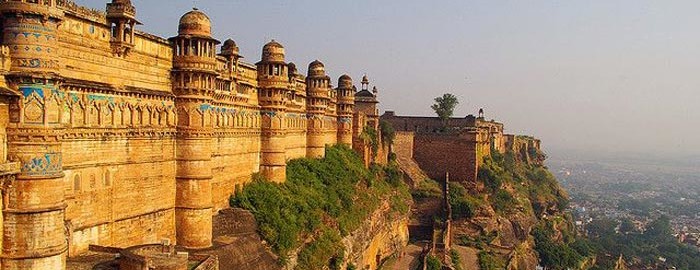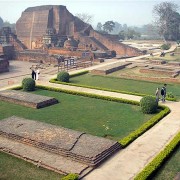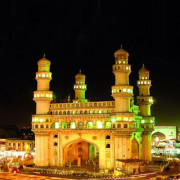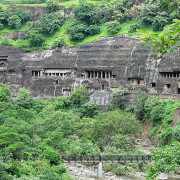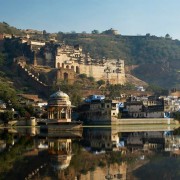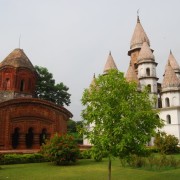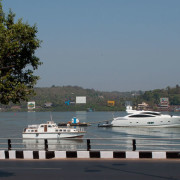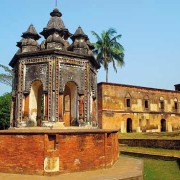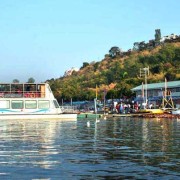Gwalior, Madhya Pradesh – The city of the forts
Located to the northern part of Madhya Pradesh, Gwalior’s tradition as a royal capital continued until the formation of present day India. From the Tomaras in the 8th century, it passed to the Mughals, then the Marathas under the Scindias (1754) having their dynastic seat here. Gwalior owes its name to Gwalipa a sage of former times. In 8 A.D, a chieftain called Suraj Sen was stricken by a deadly disease. He was cured by this hermit saint, and in gratitude founded a city which he named after the saint who had given him the gift of new life. The new city of Gwalior became, over the centuries, the cradle of great dynasties and with each, the city gained new dimensions from warrior kings, poets, musicians and saints, contributing to making it a capital renowned throughout the country. One of the most exquisite cities of India, is an integral part of the state of Madhya Pradesh.
Places to see in Gwalior: Gwalior is dotted with a number of tourist attractions. Whether someone has a taste for the age old edifices or likes to visit the most recent tech houses, Gwalior fulfils everyone’s desires.
The Fort
Standing on a steep mass of sandstone, Gwalior Fort dominates the city and is its most magnificent monument. It has been a scene of momentous events : imprisonments, battles and jauhars. A steep road winds upwards to the Fort, flanked by statues of Jain tirthankaras, carved into the rock face. The magnificent outer walls of the Fort still stand, two miles in length and 35 feet high, bearing witness to its reputation for being one of the most invincible forts of India. This imposing structure inspired Emperor Babar to describe it “the pearl amongst the fortresses of Hind.” Within the fort are some marvels of medieval architecture. The 15th century Gujari Mahal is a monument to the love of Raja Man Singh Tomar for his Gujar queen, Mrignayani. After he had wooed and won her. The outer structure of the Gujari Mahal has survived in an almost total state of preservation; the interior has been converted into an Archaeological Museum.
Also built by Raja Man Singh is the Man Mandir Palace, built between 1486 and 1517. The tiles that once adorned its exterior have not survived, but at the entrance, traces of these still remain. There is a charming frieze here of ducks paddling in turquoise waters. Within, the palace rooms stand bare, stripped of their former glory, mute testimony to the passing of the centuries. Vast chambers with fine stone screens were once the music halls, and behind these screens, the royal ladies would learn music from the great masters of the day. Below, circular dungeons once housed the state prisoners of the Mughals. The Emperor Aurangzeb had his brother, Murad, imprisoned, and later executed, here. Close by is Jauhar Pond, where in the Rajput tradition, the ‘ranis’ committed mass ‘sati’ after their consorts had been defeated in battle. Though the major portions of the Fort were built in the 15th century, references to this gigantic complex can be traced back to 425 AD. Older than the city is the Suraj Kund within the Fort walls, the original pond where Suraj Sen, or Suraj Pal as he was later known, was cured by the Saint Gwalipa.
The Sound and Lights Show Gwalior Fort
For many decades now, the Fort of Gwalior has slumbered in silence, broken now and then by the patter of curious feet and awed tones.
Come sundown, the deserted Fort is once again left with only memories for company. But now it comes alive every night. Well remembered incidents, and well-loved voices once more echo through its lonely corridors and its dark and sad facade now glows with the colours of life. Red-gold, blue-green lights illuminate every nook and cranny of the superbly tiled ‘Man Mandir’. The Gwalior Son-et-Lumiere has begun. The Sound and Light show at the Man Mandir Palace of Gwalior Fort gives you a glimpse into its glorious past. The story of this ‘pearl’ begins with the sonorous and eloquent narration by Amitabh Bachchan as Gopachal, the sutradhar (narrator).
Teli Ka Mandir
The Teli ka Mandir is a 9th century edifice, towering at 100 ft high. This is a Pratihara Vishnu temple of a unique blending of architectural styles. The shape of the roof is distinctively Dravidian, while the decorative embellishments have the typically Indo-Aryan characteristics of Northern India. Also dedicated to Vishnu is the graceful little Sas-Bahu-ka-Mandir, built in 11th century. Another landmark is the historic Gurudwara Data Bandhi Chhod built in the memory of Guru Hargobind Sahib, the 6th Sikh Guru who was imprisoned here by Jehangir for over two years. At the time of his release, he wanted 52 Hindu kings who were his fellow prisoners, released with him. Jehangir was very impressed with the Guru and agreed to his condition. And, finally, within the Fort complex, housed in the erstwhile barracks of the British soldiers, is Gwalior’s unique gift to modern India : Scindia School. Acknowledged as one of the finest schools in India, it is only fitting that the country’s young citizens receive the best educational grounding surrounded by monuments to a past which is a constant inspiration.
Jai Vilas Palace
A splendour of a different kind exists in the Jai Vilas Palace, current residence of the Scindia family. Some 35 rooms have been made into the Scindia Museum, and in these rooms, so evocative of a regal lifestyle, the past comes alive. Jai Vilas is an Italianate structure which combines the Tuscan and Corinthian architectural modes. The imposing Darbar Hall has two central chandeliers, weighing a couple of tonnes, and hung only after ten elephants had tested the strength of the roof. Ceilings picked out in gilt, heavy draperies and tapestries, fine Persian carpets, and antique furniture from France and Italy are features of these spacious rooms. Eye-catching treasures include: a silver train with cut-glass wagons which served guests as it chugged around on miniature rails on the tables; a glass cradle from Italy used for the baby Krishna each Janamashtami; silver dinner services and swords that were once worn by Aurangzeb and Shah Jehan.
There are, besides, personal mementoes of the past members of the Scindia family: the jewelled slippers that belonged to Chinkoo Rani, four-poster beds, gifts from practically every country in the world, hunting trophies and portraits. The ScindiaMuseum offers an unparalleled glimpse into the rich culture and lifestyle of princely India.
Monuments
The father of Hindustani classical music, the great Tansen, one of the ‘nine Jewels’ of Akbar’s court, lies buried in Gwalior. The memorial to this great musician has a pristine simplicity about it, and is built in the early Mughal architectural style. More than a monument, the Tansen’s Tomb is part of Gwalior’s living cultural heritage; it is the venue of a music festival on a national scale held annually in November-December. Leading musicians of the country gather here to give performances during the festival. More opulent than Tansen’s Tomb, is the sandstone mausoleum of the Afghan prince, Ghous Mohammed, also designed on early Mughal lines. Particularly, exquisite are the screens which use the pierced stone technique, as delicate as lace. The earliest freedom fighters, Tatya Tope and the indomitable Rani of Jhansi, are commemorated in memorials in Gwalior. There are cenotaphs at major public crossings, memorials to Scindia kings and queens. Throughout the city, there are these reminders of a proud past, of the great men and women of Gwalior who have their place in the nation’s roll of honour. Located near the Residency at Morar, the newly constructed SunTemple takes its inspiration from the famous KonarkSunTemple in Orissa.
Art Galleries and Museum
The Gujari Mahal Archaeological Museum houses rare antiquities, some of them dating back to the 1st century AD. Even though many of these have been defaced by the iconoclastic Mughals, their perfection of form has survived the ravages of time. Particularly worth seeing is the statue of Shalbhanjika from Gyraspur, the tree goddess, epitome of perfection in miniature. The statue is kept in the custody of the museum’s curator, and can be seen on request. The museum is open every day except Monday, from 10 am to 5 pm. The Kala Vithika is another treasure house of the arts. It remains closed on Sunday and public holidays. The MunicipalCorporationMuseum, which is open all days except Mondays, has a very fine natural history section. The old ancestral house of the legendary Ustad Hafiz Ali Khan has recently been converted into ‘ Sarod Ghar’ – Museum of Music by the Ustad Hafiz Ali Khan Memorial Trust under the patronage and guidance of his great son and sarod maestro Ustad Amzad Ali Khan. The museum has been rebuilt keeping in mind the old traditional architecture of Gwalior and houses in it ancient instruments of the great Indian Masters of yester years.
Gwalior Zoo
The zoo has some rare species of Indian wildlife kept in natural surroundings.
Nearby attractions from Gwalior: From Gwalior you can visit to places like;
Datia
69 km from Gwalior, on the Delhi-Chennai main line, Datia is a town whose antiquity can be traced back to the Mahabharata. A town of great historic significance, Datia’s seven-storeyed palace built entirely of stone and brick by Raja Bir Singh Deo in 1614, is considered to be one of the finest examples of Bundela architecture in the country. Within the palace are some fine wall paintings of the Bundela school. An interesting blending of cultures can be seen in the frescoes in a temple; Datia’s other attraction is its imposing GopeshwarTemple.
Sonagiri
This sacred Jain hill lies 3 km to the North West of Datia and is 5 km from the railway station. There are 77 Jain temples, built in rows on the hill and its slopes, and date back to the 17th century. Of these the temple dedicated to Chandranatha, the 8th of the 24 Tirthankaras, is quite a large one and the most beautiful. A large annual fair is held here in the month of Chaitra (April).
Pawaya
Known as Padmavati in ancient times is a fascinating complex of ruins, 68 km away, on the Gwalior-Jhansi road. Pawaya’s ruins still bear testimony to the days when it was the capital of the Nag Kings, in 3 AD. Particularly noteworthy is the lifesize statue of Chaksha Manibhadra of 1 AD. The ruins of the medieval fort built by the Parmars and the nearby Dhoomeshwar Mahadeo temple are Pawaya’s other attractions.
Kuno-Palpur Sanctuary, Chambal Ghariyal Sanctuary and Ghatigaon Sanctuary.
Things to do at Gwalior: Tourists to the sanctuary can enjoy its many sights by motor boats specially provided by the Forest Department of Madhya Pradesh. Complete safety within the peripheries of the sanctuary is ensured by the local authorities. And one can freely enjoy the natural wonders of the sanctuary which during the 50’s & 60’s was largely hidden due to the presence of dacoits.
Stringent measures to protect the fragile ecosystems of the sanctuary are followed by the authorities. The visitors are also advised not to disturb, spoil the serenity of the surrounding environs or help in poaching activities directly / indirectly.
Best time to visit Gwalior: Best season to visit Gwalior is from October to March, keep off freeze winter days.
How to go ?
By Air
There are regular flights to Gwalior from all major destinations.
By Bus
Gwalior is connected by regular bus service with Agra, Mathura, Jaipur, Delhi, Chandigarh, Lucknow, Bhopal, Chanderi, Indore, Jhansi, Khajuraho, Rewa, Jabalpur, Ujjain and Shivpuri.
By Rail
Gwalior is on the Central Railway’s main Delhi-Mumbai and Delhi-Chennai lines. Among other major trains, the Shatabdi and the Taj Express connect Gwalior with Delhi and Agra daily.
Where to stay ?
You will find an array of accommodation options in Gwalior in different price range and locations.
Tansen Residency: +91 (0751) 4056789, 4056777, 2340370, 4010555, 4010666.
Hotel Surbhi: +91 9425726777, 0751-2443265-66
Hotel Landmark: +91 (751) 401 1271, 401 1272, 401 1273, 234 5780
Hotel Sita Manor: +91 (751) 4010485, +91 (510) 2442956
Note : Phone numbers given above are according to the information available with us. If you find any contact number/s given above is/are incorrect or not in use, please let us know.
.
.

